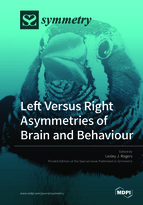Left Versus Right Asymmetries of Brain and Behaviour
A special issue of Symmetry (ISSN 2073-8994). This special issue belongs to the section "Life Sciences".
Deadline for manuscript submissions: closed (30 November 2018) | Viewed by 45164
Special Issue Editor
Interests: lateralization of brain and behaviour in vertebrates and invertebrates; development of lateralization; evolution of lateralization; function of brain asymmetry; communication in birds and primates
Special Issues, Collections and Topics in MDPI journals
Special Issue Information
Dear Colleagues,
Asymmetry of the brain and of behaviour is a characteristic of a wide range of vertebrate species, as shown by an increasing number of studies testing animals in the laboratory and in the natural environment. Recently, some asymmetries have also been found in invertebrate species. Given its ubiquity, lateralization must confer an advantage for survival, despite the apparent disadvantages of side biases in perception and response. The disadvantage is exemplified by the fact many species respond to predators more readily when seen on the left side and to prey on the right side. How do different species deal with these asymmetries and how does having a lateralized brain affect cognition?
This Special Issue is interested in papers on these topics, as well as reports of experimental evidence for asymmetry in different species and for processing different types of information. Contributions on the development, evolution and function of asymmetry are welcomed. Papers reporting research findings, reviews and theoretical discussions on asymmetry of the brain or behaviour are relevant and encouraged. Asymmetry in different sensory modalities and of motor control are also relevant topics.
Emeritus Prof. Lesley J. Rogers
Guest Editor
Manuscript Submission Information
Manuscripts should be submitted online at www.mdpi.com by registering and logging in to this website. Once you are registered, click here to go to the submission form. Manuscripts can be submitted until the deadline. All submissions that pass pre-check are peer-reviewed. Accepted papers will be published continuously in the journal (as soon as accepted) and will be listed together on the special issue website. Research articles, review articles as well as short communications are invited. For planned papers, a title and short abstract (about 100 words) can be sent to the Editorial Office for announcement on this website.
Submitted manuscripts should not have been published previously, nor be under consideration for publication elsewhere (except conference proceedings papers). All manuscripts are thoroughly refereed through a single-blind peer-review process. A guide for authors and other relevant information for submission of manuscripts is available on the Instructions for Authors page. Symmetry is an international peer-reviewed open access monthly journal published by MDPI.
Please visit the Instructions for Authors page before submitting a manuscript. The Article Processing Charge (APC) for publication in this open access journal is 2400 CHF (Swiss Francs). Submitted papers should be well formatted and use good English. Authors may use MDPI's English editing service prior to publication or during author revisions.
Keywords
- Lateralized behaviour
- Asymmetry of brain processing
- Hemispheric differences
- Development
- Evolution
- Advantages
- Disadvantages
- Influence of experience
- Vision
- Audition
- Olfaction






